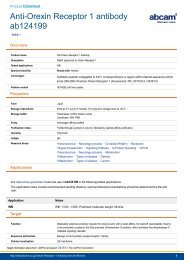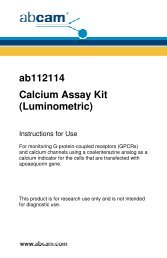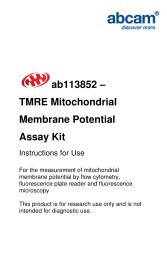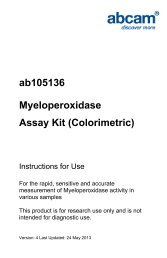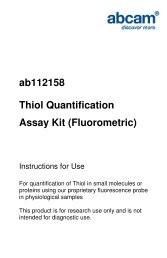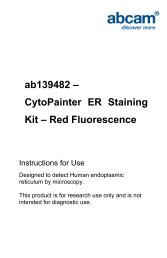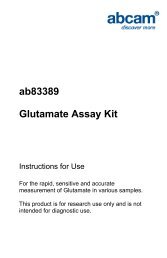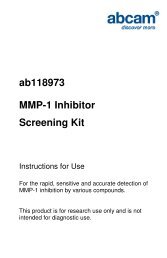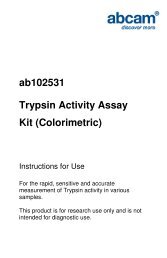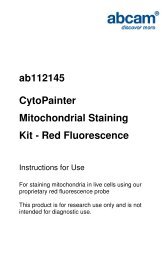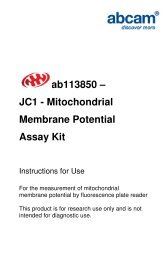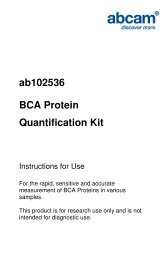ab109202 DRAQ7 1ml (0.3mM) Protocol l (0.3mM) - Abcam
ab109202 DRAQ7 1ml (0.3mM) Protocol l (0.3mM) - Abcam
ab109202 DRAQ7 1ml (0.3mM) Protocol l (0.3mM) - Abcam
- No tags were found...
You also want an ePaper? Increase the reach of your titles
YUMPU automatically turns print PDFs into web optimized ePapers that Google loves.
<strong>ab109202</strong><strong>DRAQ7</strong> TM <strong>1ml</strong> (<strong>0.3mM</strong>)<strong>Protocol</strong>Instructions for UseThis product is for research use only and is not intendedfor in vitro diagnostic use.
Table of Contents<strong>ab109202</strong> <strong>DRAQ7</strong> <strong>Protocol</strong>1. Introduction 32. Reagents Required 43. Storage and Handling 44. Overview: Use of <strong>DRAQ7</strong> 45. General <strong>Protocol</strong>s 6<strong>Protocol</strong> I: Apoptosis/ cell death by flow cytometry 6<strong>Protocol</strong> II: Real-time cell viability assays 11<strong>Protocol</strong> III: Immunofluorescence 156. FAQ 182
1. Introduction<strong>ab109202</strong> <strong>DRAQ7</strong> <strong>Protocol</strong><strong>DRAQ7</strong> is a cell impermeable far-red fluorescent DNA dye thatonly stains the nuclei in dead and permeabilized cells. It can be usedin combination with common labels such as GFP or FITC.<strong>DRAQ7</strong> is the ideal tool to study dead or membrane-compromisedcells because it does not enter intact, live cells. <strong>DRAQ7</strong> is an idealreplacement for Propidium Iodide and 7-AAD having far betterspectral properties; it has no UV excitation and no emission overlapwith PE and homologues. <strong>DRAQ7</strong> can be used in flow cytometry,cell imaging and cell-based assays and is highly compatible withexisting protocols across a wide range of instrumentation platforms.Key features of <strong>DRAQ7</strong> include:• Rapid staining of dsDNA/ nuclei of dead or permeabilizedcells• Low photobleaching effect• It can be used in most cell types, eukaryotic and prokaryotic:mammalian, bacterial, parasitic, plant, etc ...• No compensation needed with common FITC/GFP + PEcombinations in flow cytometry• No RNase treatment required3
2. Reagents Required<strong>ab109202</strong> <strong>DRAQ7</strong> <strong>Protocol</strong>• <strong>ab109202</strong>: <strong>DRAQ7</strong> <strong>1ml</strong> (<strong>0.3mM</strong>)• Phosphate Buffered Saline (PBS), without sodium azide, orother culture medium3. Storage and HandlingBefore handling <strong>ab109202</strong> <strong>DRAQ7</strong> please read the MSDSsupplied with the product.Store product at 4°C in the dark. Do not freeze.Undiluted product is stable for at least 3 years if kept under therecommended conditions. Diluted product should be used as soonas possible.4. Overview: Use of <strong>DRAQ7</strong><strong>DRAQ7</strong> is added in the final staining step of a labeling procedureas there is no further washing step required.The following chart gives an overview on where <strong>DRAQ7</strong> can beadded depending on the type of experiment.4
<strong>ab109202</strong> <strong>DRAQ7</strong> <strong>Protocol</strong>For analysis of apoptotic / membrane-compromised cells, do notpermeabilize the cells before addition of <strong>DRAQ7</strong>; otherwise thedye will stain all cells.5
5. General <strong>Protocol</strong>s<strong>ab109202</strong> <strong>DRAQ7</strong> <strong>Protocol</strong><strong>Protocol</strong> I: Cell staining with <strong>DRAQ7</strong> for dead cell / apoptosisevaluation by flow cytometry.This general protocol is a guideline, and we recommend adapting itto each user’s best protocol.Surface antibodies and apoptosis indicators (such as Annexin V-FITC) can be use together with <strong>DRAQ7</strong>. Simply incubate the cellswith those products prior to the addition of <strong>DRAQ7</strong>.A. Cell Preparation and Fixation1. Prepare cells for staining with <strong>DRAQ7</strong>: centrifuge andresuspend cells in appropriate buffer such as PBS (or otherculture media) at a concentration of ≤4 x 10 5 cells/ml in a testtube.2. For cells requiring additional fluorescent staining (eitherconjugated-primary antibody or primary and secondaryantibody), perform the immunostaining at this step. Washthoroughly after antibody incubation.6
<strong>ab109202</strong> <strong>DRAQ7</strong> <strong>Protocol</strong>B. Cell Staining3. Add <strong>DRAQ7</strong> directly as supplied to a final concentration of3µM to the cells. Alternatively, <strong>DRAQ7</strong> can be added to thefresh buffer/ media prior to resuspending the cells in it.4. Gently mix the cells by pipetting and then incubate for 5 – 30minutes at room temperature.<strong>DRAQ7</strong> staining is accelerated at 37°C and incubation timemay be reduced but this should be checked by titration and foreach cell type.Note: Protect cells from light during incubation period if otherfluorescent stains (such secondary antibodies) have beenapplied to the cells, as they may otherwise suffer photobleaching.5. Cells can be analyzed directly without further treatment orwashing, preferably within two hours.7
C. Data Analysis<strong>ab109202</strong> <strong>DRAQ7</strong> <strong>Protocol</strong>It is important to consider the combinations of fluorochromes andfilters for the experiments.EXCITATION:In flow cytometry, <strong>DRAQ7</strong> may be excited by wavelengthsfrom 488 nm and up to 647 nm (Exλ max 646 nm).Despite low absorbance at 488 nm, this excitation offers optimalCVs for flow cytometry cell cycle analysis and convenientcombination with FITC and R-PE conjugates and eGFP.EMISSION:Emission starts at 655 nm (Emλ max 681 nm/ 697 nm dsDNAbound).Suitable filters include 695LP, 715LP or 780 LP.For cell cycle analysis it is recommended to choose a filter (suchas 715LP) which excludes a significant proportion of signal fromthe small fraction of unbound <strong>DRAQ7</strong>.ANALYSIS BY FLOW CYTOMETRY: what you should expectto see8
<strong>ab109202</strong> <strong>DRAQ7</strong> <strong>Protocol</strong>To establish the position of <strong>DRAQ7</strong> (+) cells a controlexperiment may be performed:1. Analyze untreated, unstained control cells, plotting the resultsas an intensity histogram, exciting/detecting in all availablechannels to determine the negative event distribution and anybio-fluorescence.2. Analyze treated, unstained cells similarly.3. Based on both samples, adjust the instrument settings to placethe negative population in the first log decade.4. Add <strong>DRAQ7</strong> to a new aliquot of untreated control cellsaccording to the protocol.5. Split the aliquot in half, analyzing one half to establish theposition of the <strong>DRAQ7</strong> (-) cells.6. Permeabilize the remaining half of the aliquot of untreatedcontrol cells (prepared in Step 4) with the addition of 1% Triton-X100, vortex to mix and analyze to establish the position of<strong>DRAQ7</strong> (+) cells (i.e. membrane-compromised cells).Alternatively, add DRAQ5 (ab108410) at 20µM and incubatefor 10 minutes at 37°C. The position of DRAQ5 (+) events isthe upper limit for the <strong>DRAQ7</strong> (+) event signal.These control experiments should allow setting of <strong>DRAQ7</strong> (-) /<strong>DRAQ7</strong> (+) gates.Remove doublets and clumps by plotting <strong>DRAQ7</strong> peak height/width versus <strong>DRAQ7</strong> peak area.9
<strong>ab109202</strong> <strong>DRAQ7</strong> <strong>Protocol</strong>For cell cycle/ ploidy analysis, plot <strong>DRAQ7</strong> signals in linearmode.10
<strong>ab109202</strong> <strong>DRAQ7</strong> <strong>Protocol</strong><strong>Protocol</strong> II: Use of <strong>DRAQ7</strong> in real-time, dynamic cell viabilityassays.<strong>DRAQ7</strong> has been shown not to have any effect on the proliferationrate of cells in long-term culture assays.<strong>DRAQ7</strong> can therefore be used to report, in real-time, the cytotoxicor apoptotic-effect of a specific treatment on cells.For example, <strong>DRAQ7</strong> can be used to study the effect of:• A pharmacological agent• RNAi• Virus• Antibody-dependent complement-mediated killing• In vitro toxicology testingThis general protocol is a guideline, and we recommend adapting itto each user’s best protocol.A. Cell Preparation and Staining1. Prepare cells for experiment according to your protocol.Treat cells as required for your protocol.11
<strong>ab109202</strong> <strong>DRAQ7</strong> <strong>Protocol</strong>2. <strong>DRAQ7</strong> is supplied ready-to-use.Add directly to the cell culture media at a final concentration of3µM (1/1000 dilution).and mix gently.3. Remove aliquots as required and analyze for far-red (> 665 nm)fluorescing cells (relative to controls) by flow cytometry.Normal cells will not need to be washed prior to analysis.Alternatively, cells on microplates/ slides can be fixed at therequired time points for the experiment and analyzed by cellimaging microscopy.B. Data AnalysisIt is important to consider the combinations of fluorochromes andfilters for the experiments.EXCITATION:In flow cytometry, <strong>DRAQ7</strong> may be excited by wavelengthsfrom 488 nm and up to 647 nm (Exλ max 646 nm).Despite low absorbance at 488 nm, this excitation offers optimalCVs for flow cytometry cell cycle analysis and convenientcombination with FITC and R-PE conjugates and eGFP.12
<strong>ab109202</strong> <strong>DRAQ7</strong> <strong>Protocol</strong>For cell imaging, <strong>DRAQ7</strong> excitation (Exλ max 599/ 644 nm) isperformed with either 633 nm or 647 nm wavelengths.EMISSION:Emission starts at 655 nm (Emλ max 681 nm/ 697 nm dsDNAbound).Suitable filters include 695LP, 715LP or 780 LP.For cell cycle analysis in flow cytometry it is recommended tochoose a filter (such as 715LP) which excludes a significantproportion of signal from the small fraction of unbound<strong>DRAQ7</strong>.In cell imaging, <strong>DRAQ7</strong> has no spectral emission overlap withFITC, R-PE, GFP, DyLight ® 488 or many other fluoresceingproteins allowing image acquisition in one scan.ANALYSIS BY FLOW CYTOMETRY: what you should expectto seeTo establish the position of <strong>DRAQ7</strong> (+) cells a controlexperiment may be performed:13
<strong>ab109202</strong> <strong>DRAQ7</strong> <strong>Protocol</strong>1. Analyze untreated, unstained control cells, plotting the resultsas an intensity histogram, exciting/detecting in all availablechannels to determine the negative event distribution and anybio-fluorescence.2. Analyze treated, unstained cells similarly.3. Based on both samples, adjust the instrument settings to placethe negative population in the first log decade.4. Add <strong>DRAQ7</strong> to a new aliquot of untreated control cellsaccording to the protocol.5. Split the aliquot in half, analyzing one half to establish theposition of the <strong>DRAQ7</strong> (-) cells.6. Permeabilize the remaining half of the aliquot of untreatedcontrol cells (prepared in Step 4) with the addition of 1% Triton-X100, vortex to mix and analyze to establish the position of<strong>DRAQ7</strong> (+) cells (i.e. membrane-compromised cells).Alternatively, add DRAQ5 (ab108410) at 20µM and incubatefor 10 minutes at 37°C. The position of DRAQ5 (+) events isthe upper limit for the <strong>DRAQ7</strong> (+) event signal.These control experiments should allow setting of <strong>DRAQ7</strong> (-) /<strong>DRAQ7</strong> (+) gates.Remove doublets and clumps by plotting <strong>DRAQ7</strong> peak height/width versus <strong>DRAQ7</strong> peak area.For cell cycle/ ploidy analysis, plot <strong>DRAQ7</strong> signals in linearmode.14
<strong>ab109202</strong> <strong>DRAQ7</strong> <strong>Protocol</strong><strong>Protocol</strong> III: Fixed cell/ tissue staining with <strong>DRAQ7</strong> for nuclearvisualization by epifluorescence microscopy / laser scanningconfocal or HCS imaging platform.This general protocol is a guideline, and we recommend adapting itto each user’s best protocol.<strong>DRAQ7</strong> is an ideal far-red counterstain for IF/IHC assays. It stainsnucleus and cytoplasm differentially and it is spectrally compatiblewith all visible range fluors.<strong>DRAQ7</strong> will stain all fixed and permeabilized cells in thepreparation.A. Cell Preparation and Fixation1. Prepare cells for fixation.Prepare working solutions of:• 4% formaldehyde in PBS• 5µM <strong>DRAQ7</strong> solution in PBS2. Fix cells by overlaying the slide (or chamber/ well) with the 4%formaldehyde solution. Incubate for 15 – 30 minutes at roomtemperature / 37°C.15
<strong>ab109202</strong> <strong>DRAQ7</strong> <strong>Protocol</strong>3. Gently aspirate the formaldehyde solution and wash the slidewith PBS.4. For cells expressing fluorescent proteins (e.g. GFP/YFP-taggedproteins), <strong>DRAQ7</strong> can be mixed with formaldehyde fixative toprovide a one step “fix/permeabilize & stain” protocol. Toprepare, mix equal volumes of 10µM <strong>DRAQ7</strong> and 8%formaldehyde.5. For cells requiring indirect immunostaining (primary and / orsecondary antibody), block and permeabilize according to yourfavorite protocol. Wash thoroughly after antibody incubation.B. Cell Staining6. Overlay the sample with the 5µM <strong>DRAQ7</strong> solution.Alternatively, <strong>DRAQ7</strong> can be added to the fresh buffer/medium prior resuspending the cells in it.7. Gently mix the cells by pipetting and then incubate for 5 – 30minutes at room temperature.<strong>DRAQ7</strong> staining is accelerated at 37°C and incubation timemay be reduced but this should be checked by titration and foreach cell type.16
<strong>ab109202</strong> <strong>DRAQ7</strong> <strong>Protocol</strong>Note: Protect cells from light during incubation period if otherfluorescent stains (such secondary antibodies) have beenapplied to the cells, as they may otherwise suffer photobleaching.8. Cells can be analyzed directly without further treatment orwashing, preferably within two hours.C. Data AnalysisIt is important to consider the combinations of fluorochromes andfilters for the experiments.EXCITATION:For cell imaging, <strong>DRAQ7</strong> excitation (Exλ max 599/ 644 nm) isperformed with either 633 nm or 647 nm wavelengths.EMISSION:Emission starts at 655 nm (Emλ max 678 nm/ 694 nm intercalatedto dsDNA).Suitable filters include 695LP, 715LP or 780 LP.17
<strong>ab109202</strong> <strong>DRAQ7</strong> <strong>Protocol</strong><strong>DRAQ7</strong> has no spectral emission overlap with FITC, R-PE,GFP or many other fluorescing proteins allowing imageacquisition in one scan.6. FAQs1. In which type of cells can I stain with <strong>DRAQ7</strong>?<strong>DRAQ7</strong> is a DNA-specific anthraquinone dye which derivesfrom DRAQ5 (ab108410) and will therefore stain all nucleatedcells. <strong>DRAQ7</strong> will not only stain all type of nucleatedeukaryotic cells (primary or cell-line derived), but also bacterialcells (such as E. coli or Bacillus) and plant cells.However, <strong>DRAQ7</strong> does not enter live, intact cells. <strong>DRAQ7</strong>will only stain cells whose membrane is compromised, eithernaturally (apoptotic cells) or artificially (fixed and permeabilized).2. In which type of assays can I use <strong>DRAQ7</strong>?<strong>DRAQ7</strong> can be used assays where nuclear DNA staining isrequired.Examples of these assays are:• Cell imaging:o Apoptosis studies: dead or membrane-compromisedcellso Fixed & permeabilized cells (primary or cell-linederived) or tissue sections18
<strong>ab109202</strong> <strong>DRAQ7</strong> <strong>Protocol</strong>o Fixed & permeabilized tissue sections• Fluorescence In Situ Hybridization (FISH)• Flow Cytometry:o Apoptosis detectiono Dead cell gating• Cell-based HCS assayso Cytotoxicity/ viability assays3. If <strong>DRAQ7</strong> doesn’t stain live healthy cells, how can I use itin real-time viability assays?<strong>DRAQ7</strong> only enters cells with compromised cellularmembranes. This means that, as long as the cell is healthy,<strong>DRAQ7</strong> will not enter the cell and will not bind the DNA andtherefore won’t have any cytotoxic effect. <strong>DRAQ7</strong> is a verystable compound and can be used as “viability” dye over severaldays. Once the cells start to dye (either naturally or by cytotoxictreatment), <strong>DRAQ7</strong> will enter the cells and staining will bevisible.4. Does <strong>DRAQ7</strong> stain mitochondria or RNA?<strong>DRAQ7</strong> has high specificity for dsDNA and doesn’t seem tobind to RNA. Although mitochondria contain dsDNA, no<strong>DRAQ7</strong> signals seem to be detected. This makes <strong>DRAQ7</strong>the ideal tool to study cell cycle profile, as all the signal will comefrom nuclear DNA.5. Why shouldn’t <strong>DRAQ7</strong>-stained cells be washed?19
<strong>ab109202</strong> <strong>DRAQ7</strong> <strong>Protocol</strong>There is no need to wash cells for imaging or flow cytometry.<strong>DRAQ7</strong> binds stoichiometrically to the DNA and reaches anequilibrium, which could be disrupted by long washes.<strong>DRAQ7</strong> can be added at the final stage of the protocol prioranalysis, as it will be able to stain the nucleus very quickly (5minutes incubation is enough for staining). If washes areessential in protocol, we recommend very brief washes.6. Can I use <strong>DRAQ7</strong> with anti-fade mountants?Yes. <strong>DRAQ7</strong> is perfectly compatible with anti-fade mountantssuch as Fluoroshield (ab104135), BrightMount (ab103746) orBrightMount Plus (ab103748). Just ensure that the mountant isthe “native” product and does not contain DAPI as the DAPIquenches the <strong>DRAQ7</strong> staining signal.7. Which fluorochromes can I use with <strong>DRAQ7</strong>?<strong>DRAQ7</strong> emits in far-red end of the spectra and therefore iscompatible with fluorochromes with emission spectra lower than600nm.<strong>DRAQ7</strong> can be used with common labels such as eGFP/YFP,Cy2, FITC, Cy3, R-PE, and DyLight ® 488, 550 and 594.We do not recommend the use of <strong>DRAQ7</strong> with other far-redfluorochromes excited by the 488 ot 633 nm laser lines, such asPE-Cy7, PerCP-Cy5.5, APC, Texas Red or DyLight ® 650.8. How long can I keep my working dilution of <strong>DRAQ7</strong>?We recommend that if you dilute <strong>DRAQ7</strong>, you use yourworking solution as soon as possible. Do not store diluted20
<strong>ab109202</strong> <strong>DRAQ7</strong> <strong>Protocol</strong><strong>DRAQ7</strong>; the agent is very stable but the dye could be lost fromsolution since it is formulated for immediate use.For further technical questions, please do not hesitate tocontact us by email (technical@abcam.com) or phone (select“contact us” on www.abcam.com for the phone number foryour region).21
<strong>ab109202</strong> <strong>DRAQ7</strong> <strong>Protocol</strong>22
<strong>ab109202</strong> <strong>DRAQ7</strong> <strong>Protocol</strong>23
<strong>ab109202</strong> <strong>DRAQ7</strong> <strong>Protocol</strong><strong>Abcam</strong> in the USA<strong>Abcam</strong> in Japan<strong>Abcam</strong> Inc<strong>Abcam</strong> KK1 Kendall Square, Ste B2304 1-16-8 NihonbashiCambridge,Kakigaracho,MA 02139-1517Chuo-ku, TokyoUSA 103-0014JapanToll free: 888-77-ABCAM (22226)Fax: 866-739-9884 Tel: +81-(0)3-6231-094Fax: +81-(0)3-6231-0941<strong>Abcam</strong> in Europe<strong>Abcam</strong> in Hong Kong<strong>Abcam</strong> plc<strong>Abcam</strong> (Hong Kong) Ltd330 Cambridge Science Park Unit 225A & 225B, 2/FCambridge Core Building 2CB4 0FL1 Science Park West AvenueUKHong Kong Science ParkHong KongTel: +44 (0)1223 696000Fax: +44 (0)1223 771600 Tel: (852) 2603-682Fax: (852) 3016-1888<strong>DRAQ7</strong> is a trademark of Biostatus Limited.24Copyright © 2011 <strong>Abcam</strong>, All Rights Reserved. The <strong>Abcam</strong> logo is a registered trademark.All information / detail is correct at time of going to print.



